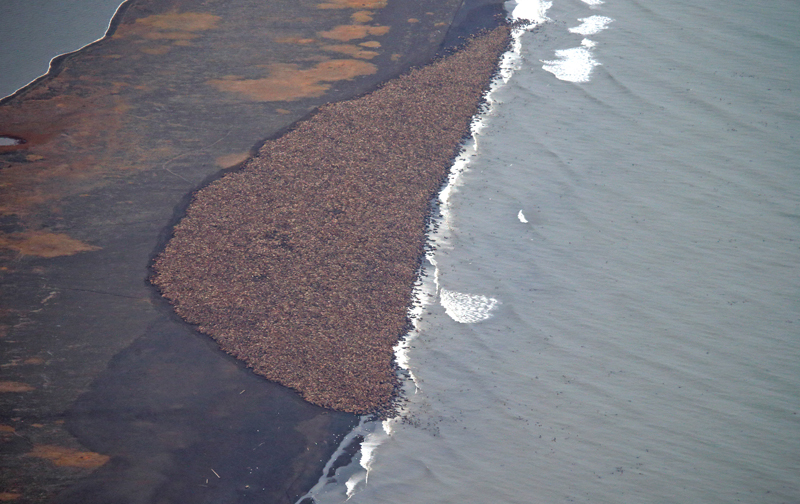If you spent any time on the internet last week, you probably saw the photos: A giant, roiling mass of 35,000 walrus crowded onto a beach in northwest Alaska. The photos, captured by the National Oceanic and Atmospheric Administration, were featured on the BBC, the Associated Press and more Twitter and Facebook feeds than anyone could count.

Most reports — with the exception of a few ultra-conservative sites — decisively linked the record numbers of on-shore walrus to record low sea ice offshore, and overnight, the walrus became an international symbol of climate change. The New York Times called the situation a “walrus crisis,” and NBC News reported that it was a “ very visual sign of what wildlife scientists know and worry about: From the Arctic to Antarctica, some species are having to adapt, or die, in the face of the long-term threat of a warming planet.”
But two walrus experts currently using a National Science Foundation grant to analyze recent, historic and prehistoric walrus samples to piece together the species’ 4,000-year history say that we don’t understand enough about “normal” walrus behavior to know whether the massive haul-out is, in fact, unusual. Nicole Misarti, a research professor at the University of Alaska Fairbanks, and Lara Horstmann, a professor of marine biology, say that it’s certainly not unprecedented: Massive haul-outs of walrus are annual events in Russia, and were recorded in Alaska in 1938. Just because the walrus haven’t hauled out in this specific location in such large numbers during the limited time we’ve been studying them doesn’t mean that the behavior is necessarily abnormal, or related to climate change.
Nonetheless, Misarti and Horstmann aren’t ruling climate change out, either. There’s no doubt that the trend of more and more walrus gathering on Alaskan beaches in recent years mirrors a decrease in Arctic sea ice, “but nobody knows enough about walrus to say whether it’s a lack of sea ice or sea ice moving in a different direction or prey moving to different areas,” Misarti says. “Those are the burning questions.”
Plus, reports claiming that the haul-out is harmful to the walrus or is a “crisis” are overblown, the researchers say. “It’s important that people realize it’s not a mass die off and it’s not a mass stranding,” Horstmann notes.
“It’s not like whales stranded on a beach. The walrus are purposely hauling out there — they’re not helpless and the numbers of trampled young are actually quite low so far,” adds Misarti.
Yet like most species, walrus numbers in Alaska have indeed decreased over the past several decades, and those that remain are vulnerable to climate change. Just as vulnerable, though, are the subsistence villages that depend on walrus. That’s why Misarti and Horstmann are combing through historic interviews and analyzing trace hormones like cortisol (the “stress hormone”) collected from bone and tooth samples to figure out how walrus populations responded to past climactic events like the Little Ice Age or the Medieval Warm Period. “We really don’t know much about walrus, so pretty much any information we can give subsistence hunters or state agencies is going to be helpful,” Misarti says.
Aiding their groundbreaking research is the fact that walrus teeth have growth rings similar to those in trees. “With a tree ring, you can look at an individual tree and how it’s changed over time,” Horstmann says.
“We’re doing some of that, but we’re also looking at groups [of walrus] over time.,” Misarti explains. “It would be like looking at ten trees from 100 years ago, ten trees from 1,000 years ago, and so on.”
Still, the lab work is slow and painstaking, and one year into a four-year study, the researchers don’t yet understand how walrus react to environmental changes. One hypothesis behind the current trend is that larger haul-outs used to be more common in Alaska, but the introduction of snowmobiles and ATVs drove the animals farther to sea. Another is that perhaps clams have flourished recently in the area, and the walrus are simply following their favorite food source. And a third, of course, is that melting sea ice is driving more females and juveniles onto shore.
Again, no one knows, but media hyperbole that oversimplifies the threats walrus do face and plays into the growing tendency to relate any unusual event to climate change only gives climate deniers a stronger case for decrying all climate science as bunk.
This story originally appeared on High Country News, HCN.org. Krista Langlois is an editorial fellow at High Country News. She tweets @KristaLanglois2.





